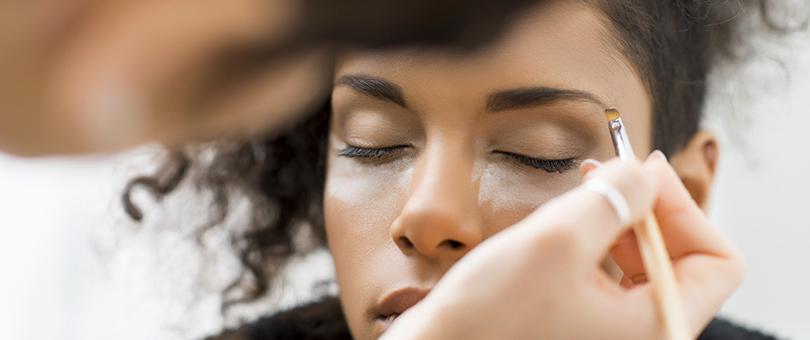Megan Cox went to bed and woke up in the morning to find that she had made $10,000 in sales overnight. At the time, she was an MIT student with a newly launched store, Amalie Beauty—her first foray into manufacturing and ecommerce.
Amalie now has six-figure sales, a history of glowing press, and products that sell out as soon as they launch.
How did it get here? Let’s rewind three years.
Megan started her business to solve a pain point: she destroyed her natural lashes and couldn’t find a restorative product that worked. After poring through the research and matching it against the products on the market, she found a gap.

Free Video Series: Ecommerce Inspiration
Feeling uninspired? Watch some of the world's most successful entrepreneurs share their best advice for new business owners.
Get our Ecommerce Inspiration video series delivered right to your inbox.
Almost there: please enter your email below to gain instant access.
We'll also send you updates on new educational guides and success stories from the Shopify newsletter. We hate SPAM and promise to keep your email address safe.
What she also found was a massive audience for her product—an army of women (and men) looking for a simple, natural solution to a common problem. Born was her online business idea. Amalie launched with the brand’s flagship product, Wink—a naturally-derived oil designed to promote regrowth of lashes and brows—and has since expanded into other natural skincare products.
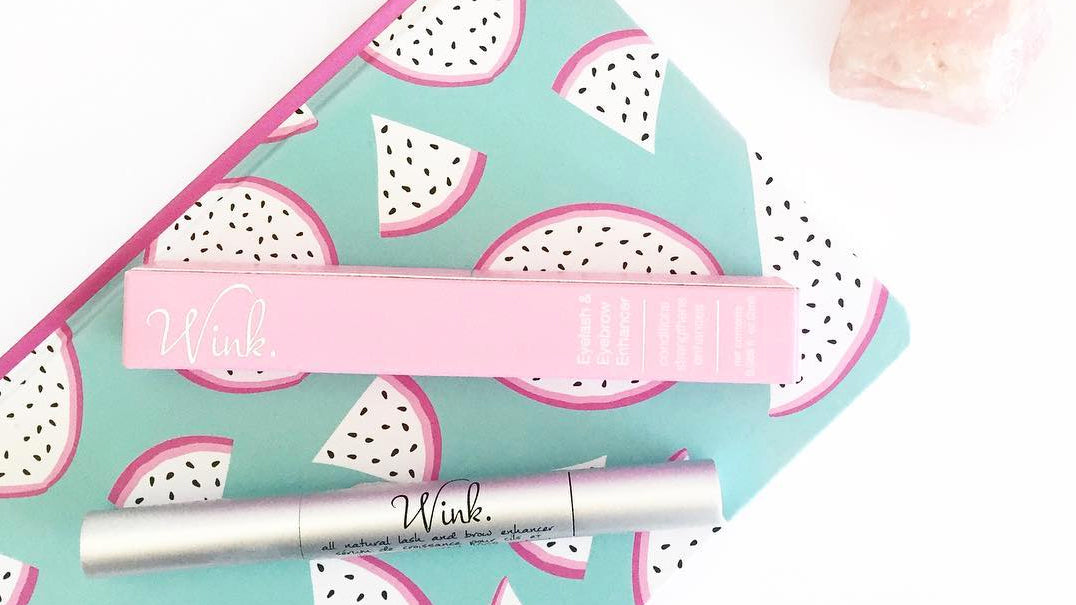
photo: @onabeautybender
Megan is growing her business from her family farm in Indiana, a small apartment in Shenzen, and on countless flights in between.
She’s learned a lot about business and manufacturing by trial and error—more than all of her MIT education put together. What can budding beauty entrepreneurs learn from her story?

Megan Cox, Founder, Amalie Beauty
Nine hard-learned lessons from Amalie Beauty Founder, Megan Cox:
1. Do your homework
Megan tapped into an industry that continues to thrive—organic personal care is expected to be a $13.2 billion industry by 2018. Once limited to small brands at health food stores, even Sephora now stocks a healthy number of large luxury brands within the natural realm. Research continues to show consumer trends towards mild, food-based, probiotic, and pollution-shielding ingredients, and a study saw organic health and beauty grow 21% in 2015 in the UK alone.
The continued upward trend is good news for new businesses in the space.
It’s no longer just a mom and pop industry. Tarte, a natural beauty line started in Founder Maureen Kelly’s one bedroom apartment in 1999, joined Sephora’s lineup in 2003, grossed $12 million in 2008, and sold majority shares in 2014 to global beauty behemoth Kose. She started the business with $18,000.
Megan had a similarly lean start, launching Amalie from her MIT dorm room after discovering a formulation that worked to restore her lashes—something no other product on the market could claim.

At the office with assistant, Charlie
She had ordered every top-rated lash enhancer on Amazon, to no avail. That’s when she tapped into MIT’s research paper database. Her sleuthing found that essential fatty acids showed promise in studies but no other company was using it in lash products.
“I went to MIT for chemistry but then after a semester I was like, ‘I'm not doing this,’ because everyone I talked to said they went into food science, which means that they work for Kraft, coming up with the newest cheese crackers. So, I switched into business.”
Her short-lived chemistry education did help her with product formulation, but she found the most useful information on the internet.
“I had some chemistry background, but really, when starting the business, I just read up online about what you needed to do—how the formulations work, what kind of testing you need to do to make sure it's stable. Thank god for the internet, because twenty years ago, I could not have started this business! All the research is out there—there are a lot of smart people on the internet sharing information for free.”
2. Just start (no excuses)
Megan tested her new formulation on friends, with positive results. They encouraged her to sell the product. “I didn’t have any money or experience,” she said (unless you count her born-with-it entrepreneurial spirit).
"I started selling things at a really young age. The first time I got in trouble in the playground was for selling things. It's my personality and was always my dream. I didn't really realize that for a while, though.”
Her initial investment was exactly $1812 (a 10th of Tarte’s original startup costs). It was every penny she had. Not allowing her meagre investment to hold her back, she incorporated the business for $700, bought 500 bottles and a few thousand boxes, and paid for her first month on Shopify. She had $6 left to her name.
Though a business major, she soon found that the skills learned in class did not actually prepare her for her own brand launch.
“When I told my parents that I had a class where we learned how to write memos and emails, they were like, ‘That's what we’re paying for!?’ That's literally the only practical thing I learned in school that I've been able to apply to my business. Although, it taught me how to push boundaries and to be humble—meeting people who were so insanely smart makes you realize that you can't ever be completely certain of yourself. You just have to keep working hard. MIT made me hungry in a way. That’s helpful for entrepreneurship.”
MIT made me hungry in a way. That’s helpful for entrepreneurship.

photo: I Know All the Words
As a newbie, marketing her product was mainly guesswork, and with no money, she needed to get creative.
She first went to Reddit, which resulted in a few sales. It was a simple call to her hometown’s local paper that was the catalyst for her big breakout. The paper interviewed her, bringing in yet a couple more sales, but the turning point was when the story was picked up by the state paper.
“I went to visit my best friend Miguel in Texas for a week before he started school. I had sold maybe four units at that point. We went to sleep and when we woke up, we had $10,000 in sales. I had no idea what happened because I'd only done one press interview and no advertising. But it was picked up through the AP. Three days after it was in my local newspaper it was in the state newspaper, which has a one million circulation. It was nuts. When I woke up, we had sold out, but the sales were still going because I hadn't put a cap on stock.”
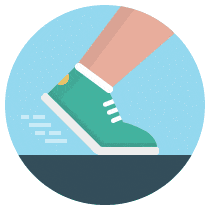
Free Reading List: Ecommerce Motivation
Having trouble focusing on growing your small business? Get access to our free, curated list of high-impact productivity articles.
Get our Ecommerce Motivation reading list delivered right to your inbox.
Almost there: please enter your email below to gain instant access.
We'll also send you updates on new educational guides and success stories from the Shopify newsletter. We hate SPAM and promise to keep your email address safe.
3. Roll with the punches
When they began exceeding their on-hand supply, Megan’s inclination was to turn it off, but Miguel said, “No way!” (she credits him as an instrumental partner in getting her business off the ground).
So they let the sales pour in. Although they only had 500 units ready to ship, and it took two months to restock and fill the rest of the orders, only two people wanted a refund.
“This was major amateur hour. I barely knew how to write an email correctly at that point. After we shipped the 500, I emailed the rest and said, 'Guys, we sold out. I'm sorry. It's going to be a while.' Everyone besides those two people were happy to wait. I gave everyone a coupon for their next order. That was a really cool way to start. I still have a lot of those customers, actually, from the very beginning.”
This was major amateur hour. I barely knew how to write an email correctly at that point.
The unexpected success came with one major logistics issue: Megan was a full-time student. Because her parents, who were paying for her education, weren’t thrilled with the distraction, they took over shipping and fulfillment until she finished school.
“It became my mom's full-time job for a year. She didn't know what she was signing up for. She shipped out all of those five hundred units and waited for the new units to come in and then shipped those too. I said, ‘Guys, this is my company. This is what I'm going to do with my life.’ They're like, ‘No, it's not. Just go to school, okay? Get your degree. We're not arguing about this.’”
It became my mom's full-time job for a year. She didn't know what she was signing up for.
4. Show your face
While the actual formulation is made in America, Megan works closely with factories in China to produce her bottles and product packaging. So closely, in fact, that she now keeps an apartment there, where she spends several months of the year closely managing the process. It’s critical to see the factories and to form relationships in person, she says.
Megan has an advantage over many other Americans doing business in China—she speaks Mandarin and some Teochew.
“If you don’t speak the language, I would say you’d have to hire a translator or work with a higher tier factory that speaks English. You're going to be paying such a premium for that. I wouldn't necessarily trust a translator or an agency if they're from China and not from your home country. It's really kind of difficult to get around."

It took Amalie six months the first time to find a factory, start production, and ship. While she has made solid relationships and honed in the manufacturing, she still plans to spend half of her time in China while she’s developing new products.
“I wish I would have come to China sooner. It gives you a lot of ideas. You just realize there are a lot of ways to go about things. Like, you don't have to just do ten thousand units. I think it’s just accepted in beauty that the minimum order is always ten thousand, ten thousand."

Final negotiations at the bottle factory
Manufacturing in China: Additional Reading & Listening
- What NOVO Watch Learned After Years of Overseas Manufacturing [Podcast]
- Make, Manufacture, Wholesale or Dropship: The Pros and Cons of Each Model
- How To Find a Manufacturer or Supplier for Your Product Idea
- Alibaba 101: How to Safely Source Products from the World's Biggest Supplier Directory
5. Test, test, then test again
She continues to live half of the time in China because she says it’s important to conduct your own tests. It’s a lesson she learned the hard way.
“Packaging was a really big issue for me—I lost a lot of my customers because it was unreliable. The brushes were glued into place but the formulation didn't mesh with the glue, so they were falling out. Now I come here and do the quality control myself. I make sure that I keep those relationships intact with my factories because I can't afford for that to happen again. I think this is my sixth trip this year. Now I just have an apartment here because I'm going back and forth all the time.”
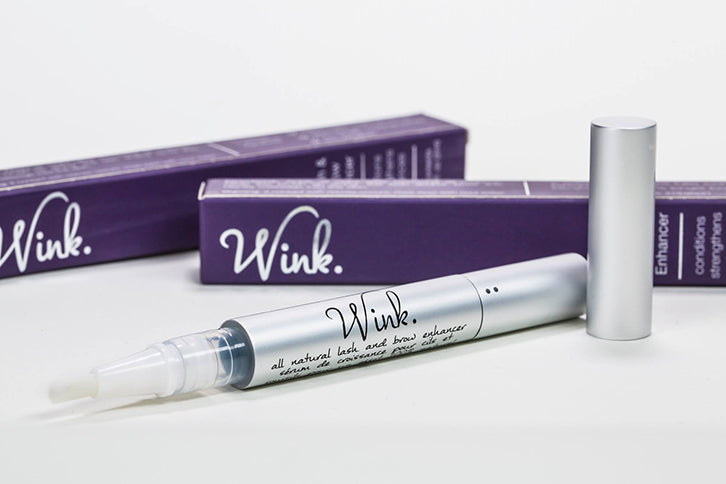
Wink Eyelash Serum
Manufacturing in North America can be more expensive, but the upside is the access to the factories, and the ability to be hands-on with the process. Megan is therefore incredulous when I ask about the internet storm over Kylie Jenner’s own packaging.
“Kylie’s factory is in California. I'm like, ‘Drive thirty minutes to your factory.’ I don't know how that kind of stuff happens. Everything needs to be tested at every single step, and unless you're a vet, you don't think about it. Her factory should have caught that.”
Everything needs to be tested at every single step, and unless you're a vet, you don't think about it.
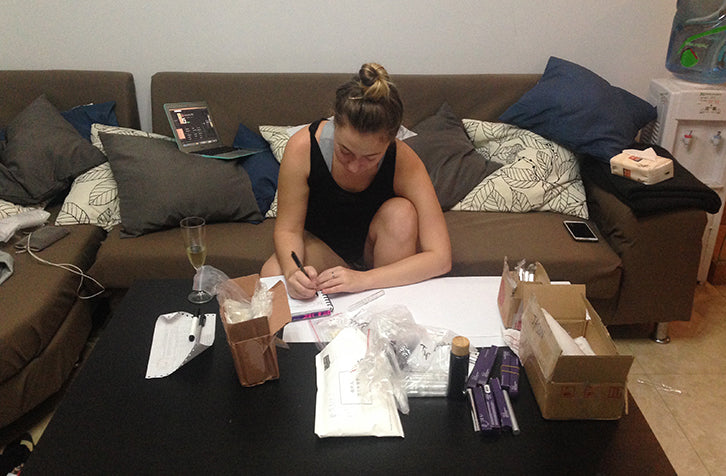
Always be testing!
She’s obsessed about testing everything, she says, including using the formulations on her own skin.
“I made a batch of a new formulation before I came to China. I brought some with me. I've been trying it out. I've been trying out new packaging. I'm always trying new things.”
6. Be a control freak, then let go
Back in the States, Wink was originally being produced and filled in a third party cosmetics lab. Her time in China however has taught her to become very particular about manufacturing, and this year she plans to take over all of the production of the formulation and bottle filling.
"When someone else is making the formulation, they're also sourcing the ingredients. I want to know where my ingredients are coming from. I want to have everything documented. I want to be there. I want to smell the formulation and know if it's right and if it's going to work. This is a really big step—moving to mass production. I'd rather do it myself and hire an employee oversee all of it, than trust it to someone else.”
I want to know where my ingredients are coming from. I want to have everything documented. I want to be there.
To manufacture cosmetics in America, the FDA sets guidelines for ventilation, air control, and surfaces. While your manufacturing processes should adhere to FDA standards, there is quite a bit of flexibility for businesses who manufacture in spurts. Mobile clean rooms—essentially pop-up tents—are designed for this purpose and ideal for a business like Amalie.
Megan has recently added another layer of complication. She’s producing the raw ingredients for her formulations, too. While it’s another step of the process that she can now manage herself, the results are unreliable.

“With this new batch, I’m actually growing the plants myself. That's an issue because it's really cool when it works out, but there's just a really big risk because you're depending on the weather, the soil, and your ability to take care of the plants everyday. I had two sets of seeds that died because it was too hot too early this year.”
Once she’s satisfied with the process, she’ll need to delegate while overseas. She’s currently growing the plants on her parents’ and grandparents’ properties, and was personally on hand to tend to them the first time. Moving forward, she’s exploring two solutions: hire people in her Indiana hometown to manage the crops in her absence, or work with local farmers.
Manufacturing Natural Cosmetic Products in America: Resources
- Becoming USDA Organic Certified
- INCI Names List and Directory of Cosmetics Ingredients
- FDA Authority Over Cosmetics: How Cosmetics Are Not FDA-Approved, but Are FDA-Regulated
- Small Businesses & Homemade Cosmetics: Fact Sheet
- EWG Skin Deep Cosmetics Database
7. Transparency = trust
Natural beauty has its own set of rules and complications, including short ingredient shelf life and a discerning, skeptical consumer.
“My products have a twelve months shelf life from the moment that they're manufactured. That creates a huge logistical problem because I can't go too big with my distribution. I won't allow my distributors to buy too much product if I don't think they can push it fast enough. I have had to replace their product a few times. Someone bought two thousand units last year and they weren't able to sell them through fast enough and I thought, ‘Those are going to expire.’ I switched them out for free. I bit a huge cost there but I'm not going to let someone have a bad product with my name on it."

photo: FutureDerm
Often with products labeled “natural” or “organic”, come customer expectation that they will be free of chemical preservatives.
"All my products now are oils and then this next batch I'm going to move to a cream. Making emulsions is a whole new skill set in cosmetic chemistry. You have to have a preservative system with it. I just don't love putting preservatives in products because people are scared of them —they all have scary names."
Under the Fair Packaging and Labelling Act, the FDA enforces proper labelling of cosmetics packaging sold in the United States. Manufacturers are required to list every ingredient in the products. That’s a fact, Megan says, that her competitors and many beauty brands try to manipulate.
“Why are you putting honey and metals and all of this garbage inside your product? It doesn't even work. They're just trying to confuse consumers on purpose. It drives me nuts. I hate when companies just put thirty ingredients in their products just so they can say, ‘You could never make it yourself. We just want to confuse you, but half of it is just complete bullshit.’”
I hate when companies just put thirty ingredients in their products just so they can say, ‘You could never make it by yourself.'
She built trust for her brand on the transparency of the ingredients. Her About Page clearly, and in layman’s terms, explains the science behind the ingredients and how each is necessary to the formulation.

“I think a lot of brands try to hedge their bets and put peptides and essential fatty acids and copper and sulphur together in one product. I don't know. You can't put a pizza and a taco and a hamburger together and make it good. You just pick one. I picked one and I just stuck with it."
In addition to honesty around her own product, she’s frank about her feelings about others on the market. When asked her opinions on a competitor lash product, she dissected the ingredient list, objectively explaining the function and risks of each.
8. Content is king
Megan’s strategic approach to content involves tapping into the popularity of beauty reviews. The overwhelming number of brands and options (do I want a mascara that’s lengthening, curling, or thickening?), unpronounceable ingredients, and smoke and mirrors marketing copy, mean that beauty consumers are turning to online reviews before buying.

She’s establishing herself as a trusted expert, dedicating much of her blog to reviewing products (other than her own) in a refreshingly researched and practical voice. She's positioned herself as the face of the brand, connecting to customers through content that's genuine and frank.
The result? Organic traffic and sales are up.
"I started blogging consistently in April. I can't believe it took me three years to get there. Now I blog about four times a week and we've had a big spike recently in organic traffic and we're starting to see sales from more organic customers. I really haven't done a lot of advertising in the last three years because in beauty, and especially with eyelash enhancers, the cost per click for adwords is crazy.”
Megan is also using content as an email list generator, offering downloadable content like "The Brow Bible" and "The Lush Lash Guide".

9. Embrace the unexpected
Since she originally developed Wink for herself, Megan assumed that her customer persona would look much like herself: younger people with natural lashes damaged through extensions or trichotillomania (a disorder characterized by pulling out one’s own hair).
“Wink really took off and we found that it really resonated with older women and people who had just gone through cancer treatment. I didn't really expect that at all. I pull my eyelashes when I get stressed, and I think a lot of people have nervous ticks like that. I thought it was going to be a really big hit with those people. I never imagined chemotherapy.”
Wink really took off and we found that it really resonated with people who had just gone through cancer treatment.
Amalie embraced the cause and actively supports cancer survivors. Recently Megan launched #PinkWINK, a campaign that donates one bottle of Wink to a cancer warrior for every bottle sold in October.
“We've helped over 25,000 women—including over 3,000 cancer warriors—restore their lashes and brows to their original beauty. “

photo: Notes From my Dressing Table
Megan developed a product backed by science and built her brand on transparency while establishing herself as a trusted beauty advisor. The strategy allowed her to stand out in a crowded market, and has paid off for the business. When Amalie launched its second product this year, it was reviewed by the #1 skincare blog and sold out in the first week.
Next week, she launches her newest collection—small batch skin oils derived from her homegrown crops—and expects to sell out to her loyal customer base. She’s driving towards another launch in the spring, too, testing every step of the way.
“Last year we made low-mid six-figure income. It may sound slow, but all of this has been growth on my initial $1800 investment three years ago. I started Amalie when I was in college, with zero income. It was always my intention to grow my own business slowly over time, and create something sustainable that I fully owned and believed in. Overall, I've to date made that initial investment back over 400X.”
